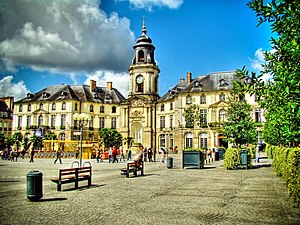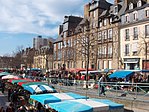Rennes
| |
|---|---|
Prefecture and commune | |
Top to bottom, left to right: Place de la Mairie; Marché des Lices; Rennes Metro; Esplanade Charles de Gaulle; Opera of Rennes by night; University of Rennes 2; and skyline of Rennes from Cathedral | |
| Motto(s): | |
 | |
| Coordinates: 48°06′53″N 1°40′46″W / 48.1147°N 1.6794°W | |
| Country | France |
| Region | Brittany |
| Department | Ille-et-Vilaine |
| Arrondissement | Rennes |
| Canton | Rennes-1, 2, 3, 4, 5 and 6 |
| Intercommunality | Rennes Métropole |
| Government | |
| • Mayor (2020–2026) | Nathalie Appéré[1] (PS) |
| Area 1 | 50.39 km2 (19.46 sq mi) |
| • Urban | 327.7 km2 (126.5 sq mi) |
| • Metro | 3,804.3 km2 (1,468.8 sq mi) |
| Population (2021)[2] | 225,081 |
| • Density | 4,500/km2 (12,000/sq mi) |
| • Urban (2018[3]) | 359,934 |
| • Urban density | 1,100/km2 (2,800/sq mi) |
| • Metro (2018[3]) | 747,156 |
| • Metro density | 200/km2 (510/sq mi) |
| Demonym | Rennais(e) |
| Time zone | UTC+01:00 (CET) |
| • Summer (DST) | UTC+02:00 (CEST) |
| INSEE/Postal code | 35238 /35000, 35200, 35700 |
| Elevation | 20–74 m (66–243 ft) (avg. 30 m or 98 ft) |
| 1 French Land Register data, which excludes lakes, ponds, glaciers > 1 km2 (0.386 sq mi or 247 acres) and river estuaries. | |
Rennes (French pronunciation: [ʁɛn] ; Breton: Roazhon [ˈrwɑːõn]; Gallo: Resnn; Latin: Condate Redonum) is a city in the east of Brittany in Northwestern France at the confluence of the rivers Ille and Vilaine. Rennes is the prefecture of the Brittany region and Ille-et-Vilaine department. In 2017, its urban area had a population of 357,327 inhabitants, while the larger metropolitan area had a population of 739,974.[3] The inhabitants of Rennes are called Rennais (masculine) and Rennaises (feminine) in French.
Rennes's history goes back more than 2,000 years to a time when it was a small Gallic village named Condate. Together with Vannes and Nantes, it was one of the major cities of the ancient Duchy of Brittany. From the early sixteenth century until the French Revolution, Rennes was a parliamentary, administrative and garrison city of the historic province of Brittany in the Kingdom of France, as evidenced by its 17th-century Parliament's Palace. Rennes played an important role in the Stamped Paper Revolt (Revolt of the papier timbré) in 1675. After the destructive fire of 1720, the medieval wooden center of the city was partially rebuilt in stone. Remaining mostly rural until the Second World War, Rennes underwent significant development in the twentieth century.
Since the 1950s, Rennes has grown in importance through rural flight and modern industrial development, partly in the automotive sector. The city developed extensive building plans to accommodate upwards of 200,000 inhabitants. During the 1980s, Rennes became one of the main centres in telecommunications and high-tech industry. It is now a significant digital innovation centre in France. In 2002, Rennes became the smallest city in the world to have a Metro line.
Labeled a city of art and history, it has preserved an important medieval and classical heritage within its historic center, with over 90 buildings protected as historic monuments.[4] Home to more than 66,000 students in 2016, it is also the eighth-largest university campus of France.[5] In 2018, L'Express named Rennes as "the most liveable city in France".[6]
- ^ "Répertoire national des élus: les maires". data.gouv.fr, Plateforme ouverte des données publiques françaises (in French). 2 December 2020.
- ^ "Populations légales 2021" (in French). The National Institute of Statistics and Economic Studies. 28 December 2023.
- ^ a b c Comparateur de territoire Unité urbaine 2020 de Rennes (35701), Aire d'attraction des villes 2020 de Rennes (013), INSEE.
- ^ "Ministère de la Culture – Maintenance". www2.culture.gouv.fr. Retrieved 31 October 2020.
- ^ "Atlas Régional - Effectis d'étudiants en 2012-2013" (PDF). cache.media.enseignementsup-recherche.gouv.fr. Archived from the original (PDF) on 27 April 2014. Retrieved 25 March 2015.
- ^ "Le palmarès 2017 des villes où il fait bon vivre et travailler". 19 February 2018.











